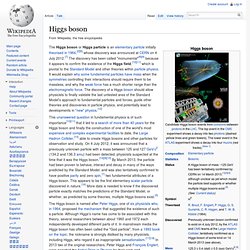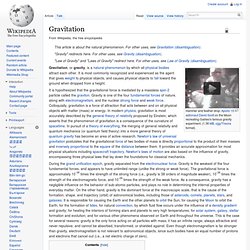

Higgs boson. The Higgs boson is named after Peter Higgs, one of six physicists who, in 1964, proposed the mechanism that suggested the existence of such a particle.

Although Higgs's name has come to be associated with this theory, several researchers between about 1960 and 1972 each independently developed different parts of it. In mainstream media the Higgs boson has often been called the "God particle", from a 1993 book on the topic; the nickname is strongly disliked by many physicists, including Higgs, who regard it as inappropriate sensationalism.[17][18] In 2013 two of the original researchers, Peter Higgs and François Englert, were awarded the Nobel Prize in Physics for their work and prediction[19] (Englert's co-researcher Robert Brout had died in 2011).
A non-technical summary[edit] "Higgs" terminology[edit] Overview[edit] If this field did exist, this would be a monumental discovery for science and human knowledge, and is expected to open doorways to new knowledge in many fields. History[edit] Weak interaction. In particle physics, the weak interaction is the mechanism responsible for the weak force or weak nuclear force, one of the four fundamental interactions of nature, alongside the strong interaction, electromagnetism, and gravitation.

The weak interaction is responsible for both the radioactive decay and nuclear fusion of subatomic particles. The theory of the weak interaction is sometimes called quantum flavordynamics (QFD), in analogy with the terms QCD and QED, but in practice the term is rarely used because the weak force is best understood in terms of electro-weak theory (EWT).[1] During the quark epoch, the electroweak force split into the electromagnetic and weak force. Most fermions will decay by a weak interaction over time. Important examples include beta decay, and the production of deuterium and then helium from hydrogen that powers the sun's thermonuclear process. History[edit] The existence of the W and Z bosons was not directly confirmed until 1983.
Properties[edit] Strong interaction. In particle physics, the strong interaction (also called the strong force, strong nuclear force, nuclear strong force or color force) is one of the four fundamental interactions of nature, the others being electromagnetism, the weak interaction and gravitation.

At atomic scale, it is about 100 times stronger than electromagnetism, which in turn is orders of magnitude stronger than the weak force interaction and gravitation. It ensures the stability of ordinary matter, in confining the elementary particles quarks into hadrons such as the proton and neutron, the largest components of the mass of ordinary matter. Furthermore, most of the mass-energy of a common proton or neutron is in the form of the strong force field energy; the individual quarks provide only about 1% of the mass-energy of a proton[citation needed].
In the context of binding protons and neutrons together to form atoms, the strong interaction is called the nuclear force (or residual strong force). History[edit] Electromagnetism. Gravitation. Gravitation, or gravity, is a natural phenomenon by which all physical bodies attract each other.

It is most commonly recognized and experienced as the agent that gives weight to physical objects, and causes physical objects to fall toward the ground when dropped from a height. During the grand unification epoch, gravity separated from the electronuclear force. Gravity is the weakest of the four fundamental forces, and appears to have unlimited range (unlike the strong or weak force). The gravitational force is approximately 10-38 times the strength of the strong force (i.e., gravity is 38 orders of magnitude weaker), 10-36 times the strength of the electromagnetic force, and 10-29 times the strength of the weak force. As a consequence, gravity has a negligible influence on the behavior of sub-atomic particles, and plays no role in determining the internal properties of everyday matter.
History of gravitational theory Scientific revolution Newton's theory of gravitation General relativity.